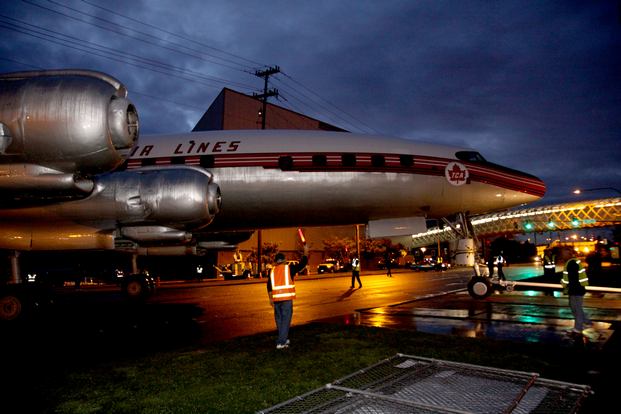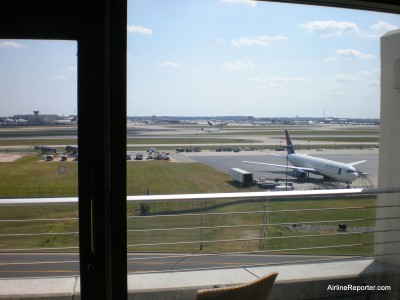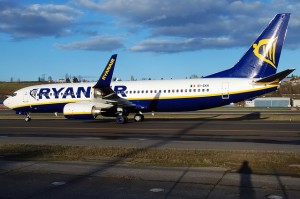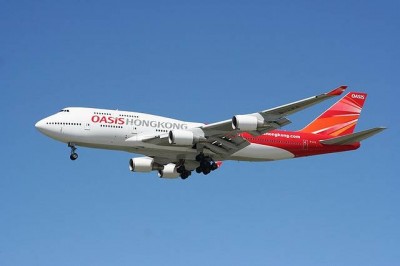
The Seattle Museum of Flight's Lockheed 1049G Super Constellation (CF-TGE) is towed across East Marginal Way South from Boeing Field into the museum's Airpark. (Ted Huetter/Museum of Flight)
Ah lack of sleep, it bites. Early Saturday morning (we are talking 3am), I was set up to head down to the Boeing Plant Building 2 to check out restored aircraft being stored by the Museum of Flight. Lack of sleep and a full day of activity (flying back from Atlanta), I totally slept through my alarm at 2am…oops.
Luckily, Ted Huetter with the Museum of Flight did not have the same problem and was able to share some photos.
Historic Plant 2 is famous for building so many bombers for World War II. The plant is set to be destroyed to make better use of the land. Inside the plant lived a B-17, B-29 and aLockheed Super Constellation all owned by the Museum of Flight.
Boeing isn’t saying when the building needs to come down, but they gave notice to the Museum of Flight they need to move their planes.
The planes had to cross a busy road and how do you go about doing that? Well, you do it at 3am…that’s how. All three aircraft were moved from old Plant 2 to the museum. The B-29 was moved to a ramp outside of Hangar 7 at Galvin Aviation and will be stored temporarily. The B-17 is being stored in a hangar at Clay Lacy Aviation. Finally the Constellation will be stored at the Airpark.
MORE GOODIES:
* A few photos on the Museum of Flights Facebook
* 27 photos taken by the Museum of Flight on the Seattle PI
* Photo of Boeing Plant 2 from the water
* Destruction of Plant 2 to help environment restoration via Seattle PI
* Photo of the Super Constellation from 1959

This is the amazing view from the Renaissance Concourse Hotel next to Atlanta's airport
I know… what am I doing talking about a hotel on my airline blog? Well don’t worry, it is totally airline related. While chilling with Delta in Atlanta I stayed at the Renaissance Concourse Atlanta Airport Hotel. Yea, the room was really nice, so was the lobby, but that is not why I am writing about it. It is located right next to the airport (and I mean next to the airport).
You are able to sit out on your balcony and enjoy all the action that Atlanta’s airport has to offer. If you aren’t an airline enthusiast, getting a room on the airport side might not suit your fancy (or ears). However, if you love airlines, you can’t find a better place to stay in Atlanta.
Sitting on the balcony, enjoying the planes, maybe add a beer and you are living the life. The only thing I wish they had was Wi-Fi (they have ethernet) internet to enjoy on the balcony.
So next time you are staying in Atlanta, be sure to stay there, you will not regret it. They even offer Plane Spotter Specials! (and no, I was not paid by the hotel to write this…I just wanted to share since it is a pretty unique experience). If you have had a hotel experience like this, please share. I would love to go visit!
Stay tuned in the coming weeks for me to share some pretty cool stuff that I learned and experienced during my time with Delta.

Ryanair Boeing 737-800 (EI-EKK) at Boeing Field before being delivered to Ryanair
Ryanair’s CEO Michael O’Leary is known for saying crazy things. Standing seats, paid toilets and more recently flying with only one pilot. This bizarre approach gets him and Ryanair a lot of free publicity. It is a genius way to do things, because it works.
Well O’Leary recently said some very interesting things that was reported by The Guardian and he isn’t getting much attention. It is odd because this is some of O’Leary’s craziest stuff ever: he wants Ryanair to improve in quality.
He told the Guardian that he feels Ryanair is maturing and with growth, they need a new strategy and a new leader. O’Leary feels that the airline needs to talk more about what they can offer versus being the cheapest airline at all costs.
Whoa! What? Does that mean no more crazy rants? Well don’t get too excited, because even though he says he should leave, he also says he won’t leave until the airline doubles in size.
O’Leary stated, “When we are twice the size we are now, at around 400 aircraft, then the growth rate slows down to 2% or 3% per year. The shareholders will want a return. You will need a different management then. We won’t need my dog and pony show, which is about generating publicity. Every company has to move from being the high-growth Robin Hood.”
Well, at least he knows his shenanigans is just a show.
Ryanair has already been moving into larger airports and away from their small airport game plan. They say they want to bring up their image, but I am almost thinking they just want to bring up the price of a ticket and increase their profit.
Love Ryanair or hate them, they have a model that works. They can do almost whatever they want because they charge so little? Why change something that works? If they move out of the crazy realm, I am sure other airlines would be more than happy to step up.
Image: Drewski2112

Boeing's mock up of what the CST-100 will most likely look like. Photo from Boeing.
The Boeing Company has been making things that go into space for quite some time now. Earlier in the week, they announced plans to possibly start sending normal Joe-Schmos into space…for a price.
Boeing and Space Adventures have created a memorandum of agreement regarding the marketing the transportation of passengers on commercial flight board the Boeing Crew Space Transportation-100 (or CST-100) to low Earth orbit.
Boeing plans to use the CST-100 to transport crews to the International Space Station, but will also provide room for private individuals, companies and pretty much anyone who isn’t NASA to hitch a ride.
Boeing and Space Adventures have not yet set a price per seat for spaceflight participants, but will do so when full-scale development is under way. Boeing continues to advance its design for the CST-100 spacecraft under NASA’s Commercial Crew Development Space Act Agreement. The spacecraft, which can carry seven people, will be able to fly on multiple launch vehicles and is expected to be operational by 2015.
“We are excited about the potential to offer flights on Boeing’s spacecraft,” said Eric Anderson, co-founder and chairman of Space Adventures. “With our customer experience and Boeing’s heritage in human spaceflight, our goal is not only to benefit the individuals who fly to space, but also to help make the resources of space available to the commercial sector by bringing the value from space back to Earth.”
At this point there is no cost set up for these flights, but don’t expect them to be cheap.
In my opinion this is awesome. Virgin Galactic is already well on their way to start space tourism and getting a big company like Boeing involved will just up the stakes and create competition.
View cutaway image

Oasis Hong Kong Airlines Boeing 747-400 ( B-LFC) at Vancouver
Oasis Hong Kong Airlines used five Boeing 747-400’s to provide low-cost service from Hong Kong to London and Vancouver, but it didn’t work out for them.
The problems they encountered during the first flight, should have been weary. The airline’s first flight back in October 2006 had its fly-over rights pulled by Russia just an hour before take off. This caused the flight to be delayed for 24 hours…not a good start.
The airline’s low fares were popular, but they weren’t enough to cover their costs. In April 2008, the airline went under.
One of the cool things about it going under is there are quite a few cool pictures of four of the Boeing 747-400’s hanging out together.
The livery is nothing too special, but I think it works. Big writing with the name going down the side of the aircraft and the tail looks like a party.
Image: SteveWilcox




